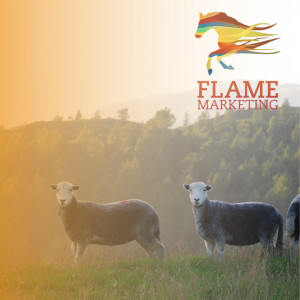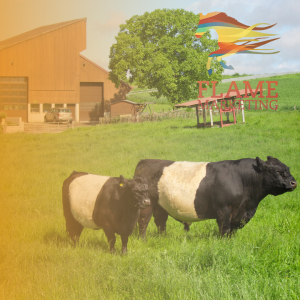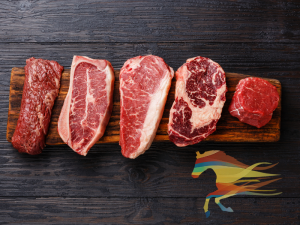

One of the simplest farm diversification options is to sell your farm produce directly to consumers. When selling to large processers, most small family farms are unable to make a reasonable living from their farming activities alone. However, by cutting out the middle man and selling directly to the consumer, you can significantly increase your profit margins and hence earn the best possible price for your produce.
activities alone. However, by cutting out the middle man and selling directly to the consumer, you can significantly increase your profit margins and hence earn the best possible price for your produce.
However, the downside of selling to the public is that you are responsible for managing the whole production and sales process. This can be a daunting undertaking, but the key is to think through each process clearly, test your processes and ideally speak to experts or business professionals who can advise and support you. In this blog, I am going to focus specifically on the marketing aspects of planning your direct sales farm diversification. If you are looking to sell meat directly, I would also recommend checking out our blog, 5 things to consider before launching your meat box farm diversification.
An ideal customer also called an ICA, is your image or description of your perfect customer. This is not to say that these will be your only customers, but these are the customers that you should focus on, the ones you should market to and the ones that will make your business a success.
 It is unlikely that your diversification project is a completely new idea. The truth is there is now growing competition in many of the common diversification sectors, such as glamping. Due to this, it is now more important than ever that you have a keen understanding of the specific market you want to target. We are all bombarded with a huge quantity of marketing messages and content every day and therefore there is a huge amount of noise to cut through with your marketing messages. Being specific helps you to do this.
It is unlikely that your diversification project is a completely new idea. The truth is there is now growing competition in many of the common diversification sectors, such as glamping. Due to this, it is now more important than ever that you have a keen understanding of the specific market you want to target. We are all bombarded with a huge quantity of marketing messages and content every day and therefore there is a huge amount of noise to cut through with your marketing messages. Being specific helps you to do this.
We often deal with farmers who view everyone as their customer and although we understand that view, it is simply not effective when selling or marketing online.
Your ideal client should be the customer who you most like working with, the one that makes you the most profit and the one who best fits your overall ethos for the business. Picture your best client, the one that really values what you do, never quibbles on price and is an advocate for your business.
Consider why this ideal client particularly values your product. Go beyond the basic ideas of ‘they like our meat’ to wider ideas about their beliefs and ethics. Do they choose to buy from you because they care about supporting small independent farms? Or is it because they what to buy direct so they can see how well the animals are cared for? Or is it for egotistical reasons, so they can show off to friends how ethical and different they are?
If you want to dig deeper into how you develop an ICA and indeed, how to work out what makes them tick then check out our free farm marketing strategy workbook here.
When planning your farm diversification project, you need to consider how you want to present your product to the public. A large part of this decision is how you price your products. I would recommend working out the absolute minimum pricing that works for your products – what is the amount you have to get to break even, then add between 5–10% depending on your farm diversification structure. This price is your baseline: the one that you use to ensure, even when on offer or sale, your products are still profitable.
absolute minimum pricing that works for your products – what is the amount you have to get to break even, then add between 5–10% depending on your farm diversification structure. This price is your baseline: the one that you use to ensure, even when on offer or sale, your products are still profitable.
Then look to competitors to consider their pricing options and make a list of suitable comparisons to give you an idea of market value. You can then cross reference this with your ideal price point and the type of pricing you feel your ICA will respond to.
You should also look to consider what your long-term plans for the business are. For example, if you are looking to sell a high-end product to a higher-end customer you will likely need to take on upfront investment. This is because a higher-end customer is likely to have higher expectations of your processes, customer services and branding feel. This means you may need to consider the costs of repaying finance in your breakeven analysis. Try some of the below questions to get you started.
As part of this you will also need to consider what specific products you are going sell. For example, are you going to simply provide a set meat box which includes a mix of cuts? Or are you going to offer the option to buy individual products such as steaks, etc.? This also ties in with considerations regarding butchery and choosing the right ideal client for your specific product offering. Our other blogs go into more details on this area, but as an example, you may choose to offer a range of products such as Lamb2ewe and Gressingham Duck do. Or you may choose something extremely exclusive and high end such as the approach of Beef en Primeur as seen by the Horned Beef Company.
You will also need to think about packaging. When considering packaging you need to balance practicality with design. Your packaging should support your marketing and farm brand development. To ensure you get the best possible value for your work and produce your goal is to create a recognisable farm brand. Your packaging forms a large part of this; consider brands such as Gressingham Duck who have highly recognisable and consistent packaging across all of their products.
Your packaging also needs to reflect the type of consumer you want to attract. If you want to pitch your meat as a high-end product with that high-end price tag then your packaging must match this too. Otherwise, customers will feel let down by the product. We eat with our eyes and expensive wine tastes better when it comes in a fancy bottle; the same is true for any farm diversification product. As a rule of thumb, darker/richer colours tend to create a sense of luxury or high-end value, whereas white packaging and even bright red can create a sense of budget or low-end value. Equally, some visual cues remind customers of specific values you may have as a business; green packaging is often associated with eco-friendly or natural products. The key here is that your packaging matches your ideal customer and the type of market you are trying to target.
 If you want to create a farm business that is truly scalable and successful you need to focus on creating a farm brand. To do this you need to ensure that you have clear processes that you follow so that customers receive the same level of service every time they buy from you. Have you considered how products will get from your farm to the customer? You need to consider how customers will interact with you, how they will order from you and how they will receive their products.
If you want to create a farm business that is truly scalable and successful you need to focus on creating a farm brand. To do this you need to ensure that you have clear processes that you follow so that customers receive the same level of service every time they buy from you. Have you considered how products will get from your farm to the customer? You need to consider how customers will interact with you, how they will order from you and how they will receive their products.
One of the simplest methods for selling to the public is the vending machine option. This is simply a modern take on farm gate sales but it allows you to have produce available throughout the day without having to be present to take orders. This works well if you have plenty of passing trade and are looking to sell produce that copes well with being in a refrigerated vending machine for the day, for example, dairy products, eggs and some meat options. However, this is unlikely to be suitable for beef and lamb producers.
Another option is to offer collection from the farm. There are two main considerations here. Firstly, safety; how will you ensure the safety of the public when coming to your farm to collect produce. Secondly, how will you manage collection times and do you really want the public to be walking around your farm at random times? The answers to these questions are highly personal and will be significantly impacted by the location and layout of your farm.
Additionally, by only offering collection you are likely to be sustainably limiting your customer base. When we have previously completed research for direct sale food businesses, we have found that the vast majority of consumers expect to be able to have food delivered, particularly in the case of single product farm diversifications. For those who have mixed livestock and can create a wider shopping experience, then there is some demand for a physical farm shop when consumers can visit. But this is a much larger project and requires extensive planning.
consumers expect to be able to have food delivered, particularly in the case of single product farm diversifications. For those who have mixed livestock and can create a wider shopping experience, then there is some demand for a physical farm shop when consumers can visit. But this is a much larger project and requires extensive planning.
Therefore, it is likely the most suitable option for most meat producing farm diversifications would be to offer delivery options to consumers. You will need to undertake research to find out which couriers will offer delivery for meat in your area and how best to package meat for travel.
This is a topic that is far too broad to cover entirely within this blog. However, we will look at some key points for deciding on a website in this blog. If you would like to find out more about this topic, check out this previous blog or book a consultation with us.
 We often speak to farmers who have rushed in to having a website built fairly cheaply by the first web designer they could find, or indeed, have tried to build one themselves using a platform such as WIX. I completely understand the attraction of these type of platforms but there is one huge issue: your website is pointless if no one can find it.
We often speak to farmers who have rushed in to having a website built fairly cheaply by the first web designer they could find, or indeed, have tried to build one themselves using a platform such as WIX. I completely understand the attraction of these type of platforms but there is one huge issue: your website is pointless if no one can find it.
When websites are built very quickly and/or cheaply, they often lack the correct structure and design to rank well on Google and hence suffer from poor online visibility. This makes them almost useless as a marketing and sales driving tool.
I hate having to tell new customers that their website is unsalvageable and that they are better off starting from scratch but it is so often the case. We will always do our best to look at what we can use of the old website or work around things if possible, but we also pride ourselves on being honest about the likely impact of doing this. We always want to ensure you get the best possible results from your website and this often means starting from scratch. So please, if you haven’t got a site built yet consider having a free consultation with us and a chat with our expert consultants to ensure you get a website that will give you real results and a tangible return on investment.
Key to making any website a success is on-going new content. Many clients think that once a site is built it can simply be left and will continue to be successful. But websites are only effective if they are updated regularly; this is both to keep your customers coming back for more and to ensure you keep Google happy, which gives you the improved visibility online.
The easiest way to add new content to a website is to add blogs. For food-focused farm diversifications this can be in the form of recipes. Recipes are a perfect option for blogs as they keep customers interested, allow you to rank on Google for specific food related terms and highlight your knowledge about your product. On top of recipes, blogs about your farm and how the food is produced often work well as do news pieces about your farm or industry.
As a farm business, time and money are often limited so it is much more effective to choose a limited number of highly relevant marketing channels rather than attempt to use every marketing channel on offer. When choosing your regular marketing channels, you need to consider where your ideal customer is likely to be found and where they will be searching for the solution to their problem. I would normally recommend only using 3–6 regular marketing channels for most small–medium sized businesses.
As a rule of thumb, this should include at least 1 offline channel and no more than 2 (or at absolute most 3) social media platforms.
In this blog I am not going to go into detail about all social media platforms, the pros and cons of each or which is the most effective for your specific business. Instead, I am going to offer some general advice regarding planning marketing content for social media. If you would like to find out more details on using social media for your farm marketing, I would check out the following blogs:
The keys to successful marketing through social media are good content and consistency. Marketing for farm diversification projects only works when you consistently target your ideal customer in an effective way. Sending out one Facebook ad campaign, no matter how well crafted, is not going to lead to a reliable and quality income stream for your farm diversification business.
For example, you should ideally be posting to your social media platforms at least 5 times per week. This stat will vary depending on the platform and the business, but I would normally consider social media as a daily marketing task. That doesn’t mean you have to do it once per day. If you find it easier to write content in blocks and then use a scheduling system to post the content that is fine too. The key is to be consistent and to find what works for you and your lifestyle. It is also worth investing in either a decent camera or a suitable smart phone and then getting a few entry-level gadgets to take really good pictures, such as a little gimble or stand.
marketing task. That doesn’t mean you have to do it once per day. If you find it easier to write content in blocks and then use a scheduling system to post the content that is fine too. The key is to be consistent and to find what works for you and your lifestyle. It is also worth investing in either a decent camera or a suitable smart phone and then getting a few entry-level gadgets to take really good pictures, such as a little gimble or stand.
You also need to consider if you really want to be in control of your social media marketing. If you lack confidence on social media or don’t have the time to commit to it, consider working with a marketing company such as us early on to ensure that your marketing is consistent across all channels.
If you are using Facebook or Instagram as part of your social media marketing strategy it is also worth considering the use of social media advertising or paid posts. On both of these platforms there are extensive targeting options for advertising and these have a huge impact on reach and can bring in new customers to your content. I wouldn’t suggest relying on them exclusively but they should form some part of your farm marketing strategy.
As BPS reduces and farmers are left with even less income, the government has started to offer more funding for developing new farm diversification projects. We are not sure how long this funding will last or the exact extent of it so our advice is to go for it as soon as you can. Find out more about the countryside productivity scheme here and to find out more about leader funding click here.
Additionally, there is the option to look at funding and investment options from providers such as Folk2Folk. Or you may choose to go down the route of crowdfunding such as through Kickstarter and similar platforms.
Regardless of the funding option you choose make sure you have advice on how best to complete applications, and speak to accountants and business professionals to ensure you have factored in enough funding for all aspects of the business, including marketing.
We would also recommend seeking support from marketing advisors. You can Check out our farm marketing strategy guide here, or you can book a consultation with us here.